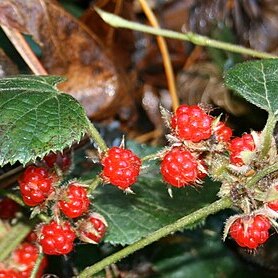Shrubs erect to creeping. Stems often rooting at nodes; stolons to 2 m, brownish to reddish brown, stolons and flowering branchlets densely tomentose-villous, unarmed or with sparse, minute prickles. Leaves simple; petiole 4–9 cm, densely tomentose-villous, sometimes with sparse prickles; stipules caducous, free, 7–10 mm, palmatipartite or pinnatipartite, lobes linear or linear-lanceolate, soft hairy; blade ovate to suborbicular, 5–11 cm in diam., palmately 5-veined, lateral veins 2 or 3 pairs, prominently raised abaxially, abaxially densely tomentose, with soft hairs along veins when young, hairs deciduous in age, adaxially slightly soft hairy or only hairy along veins, base cordate, margin 5–7-lobed, lobes unevenly sharply serrate, apex obtuse, rarely acute. Inflorescences terminal or axillary, short subracemes, 4–6 cm, few flowered, or flowers several in clusters in leaf axils; rachis and pedicels densely tomentose-villous, with sparse prickles or not; bracts 7–9 mm, palmatipartite or pinnatipartite; lobes linear, villous. Pedicel 5–9 mm. Flowers 6–10 mm in diam. Calyx abaxially yellowish villous and tomentose; sepals erect in fruit, rarely reflexed, lanceolate or ovate-lanceolate, 5–9 × 3–5 mm, apex acuminate; outer sepals often lobed apically, inner sepals entire. Petals white, obovate, nearly as long as or slightly longer than sepals, glabrous, apex erose. Stamens many, shorter than petals; filaments linear, glabrous. Pistils glabrous, longer than stamens. Aggregate fruit purplish black, subglobose, 6–10 mm in diam., glabrous; pyrenes coarsely rugose. Fl. Jul–Aug, fr. Sep–Oct. 2n = 42*, 56*.
More
An evergreen climber. The stems form roots on touching the ground. The stems have brown and white hairs. There are few prickles. The stems are 2 m long. The leaves are simple and almost round. They are 4-8 cm across. The base is heart shaped. There are 5 shallow lobes. There are irregular teeth. The flowers are white and 1 cm across. There are 4-10 together crowded in the axils of leaves. The fruit is round and 6-9 mm across. They are red.
Can be grown by cuttings or seedlings. Seeds needs stratification.

